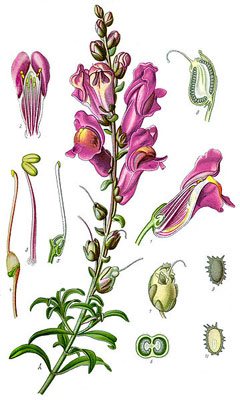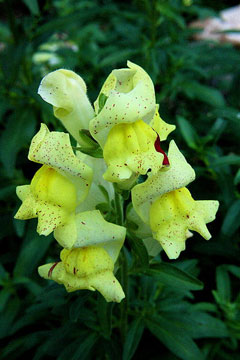 |
|
http://commons.wikimedia.org/wiki/File:Illustration_Antirrhinum_majus_clean.jpg |
 |
| http://en.wikipedia.org/wiki/User:IvanTortuga |
Translate this page:
Summary
Bloom Color: Blue, Orange, Pink, Purple, Red, White, Yellow.
Main Bloom Time: Early summer, Early fall, Late summer, Late spring, Mid summer. Form: Upright or erect.
Physical Characteristics

 Antirrhinum majus is a PERENNIAL growing to 1 m (3ft 3in) by 0.2 m (0ft 8in) at a medium rate.
Antirrhinum majus is a PERENNIAL growing to 1 m (3ft 3in) by 0.2 m (0ft 8in) at a medium rate.
See above for USDA hardiness. It is hardy to UK zone 6 and is not frost tender. It is in flower from July to September, and the seeds ripen from August to October. The species is hermaphrodite (has both male and female organs) and is pollinated by Bees. The plant is self-fertile.
Suitable for: light (sandy) and medium (loamy) soils, prefers well-drained soil and can grow in heavy clay and nutritionally poor soils. Suitable pH: mildly acid, neutral and basic (mildly alkaline) soils. It can grow in semi-shade (light woodland) or no shade. It prefers dry or moist soil.
UK Hardiness Map
US Hardiness Map
Synonyms
Plant Habitats
Cultivated Beds; East Wall. In. South Wall. In. West Wall. In.
Edible Uses
Edible Parts: Oil
Edible Uses: Oil
An oil that is little inferior to olive oil is said to be obtained from the seeds[4]. The report also says that the plant has been cultivated in Russia for this purpose[4]. The seeds are very small and I wonder about the authenticity of this report[K].
References More on Edible Uses
Medicinal Uses
Plants For A Future can not take any responsibility for any adverse effects from the use of plants. Always seek advice from a professional before using a plant medicinally.
Antiphlogistic Bitter Resolvent Stimulant
The leaves and flowers are antiphlogistic, bitter, resolvent and stimulant[7, 115]. They have been employed in poultices on tumours and ulcers[4]. It is effective in the treatment of all kinds of inflammation and is also used on haemorrhoids[7]. The plant is harvested in the summer when in flower and is dried for later use[7].
References More on Medicinal Uses
The Bookshop: Edible Plant Books
Our Latest books on Perennial Plants For Food Forests and Permaculture Gardens in paperback or digital formats.

Edible Tropical Plants
Food Forest Plants for Hotter Conditions: 250+ Plants For Tropical Food Forests & Permaculture Gardens.
More

Edible Temperate Plants
Plants for Your Food Forest: 500 Plants for Temperate Food Forests & Permaculture Gardens.
More

More Books
PFAF have eight books available in paperback and digital formats. Browse the shop for more information.
Shop Now
Other Uses
Dye Oil
A green dye is obtained from the flowers, it does not require a mordant[168]. Dark green and gold can also be obtained if a mordant is used[168].
Special Uses
Food Forest
References More on Other Uses
Cultivation details
Landscape Uses:Border, Container, Foundation, Massing, Specimen, Woodland garden. Prefers a light well drained loam and a sunny position[1, 200]. Plants are tolerant of clay and lime soils, and also grow well on old walls[200]. Plants are often grown as an annual since they usually degenerate in their second year[1]. They often self sow when well-sited[K]. There are many named forms, selected for their ornamental value[200]. Special Features:Not North American native, Naturalizing, Attracts butterflies, Suitable for cut flowers, Suitable for dried flowers, Fragrant flowers.
References Carbon Farming Information and Carbon Sequestration Information
Temperature Converter
Type a value in the Celsius field to convert the value to Fahrenheit:
Fahrenheit:
The PFAF Bookshop
Plants For A Future have a number of books available in paperback and digital form. Book titles include Edible Plants, Edible Perennials, Edible Trees,Edible Shrubs, Woodland Gardening, and Temperate Food Forest Plants. Our new book is Food Forest Plants For Hotter Conditions (Tropical and Sub-Tropical).
Shop Now
Plant Propagation
Seed - surface sow March in a greenhouse. The seed usually germinates in 10 - 21 days at 18°c[134]. Cool nights assist germination[134]. When large enough to handle, prick the seedlings out into individual pots and plant them out in the summer. The seed can also be sown in situ in July/August and will produce larger and more floriferous plants the following summer. Cuttings of half-ripe wood in September in a cold frame[200].
Other Names
If available other names are mentioned here
Native Range
TEMPERATE ASIA: Cyprus, Israel, Lebanon, Syria, Turkey EUROPE: Albania, Greece (incl. Crete), Croatia, Italy (incl. Sardinia, Sicily), Malta, Serbia, Spain (incl. Baleares), France (south), Portugal AFRICA: Algeria, Libya, Morocco, Tunisia
Weed Potential
Right plant wrong place. We are currently updating this section.
Please note that a plant may be invasive in one area but may not in your area so it's worth checking.
Conservation Status
IUCN Red List of Threatened Plants Status :

Growth: S = slow M = medium F = fast. Soil: L = light (sandy) M = medium H = heavy (clay). pH: A = acid N = neutral B = basic (alkaline). Shade: F = full shade S = semi-shade N = no shade. Moisture: D = dry M = Moist We = wet Wa = water.
Now available:
Food Forest Plants for Mediterranean Conditions
350+ Perennial Plants For Mediterranean and Drier Food Forests and Permaculture Gardens.
[Paperback and eBook]
This is the third in Plants For A Future's series of plant guides for food forests tailored to
specific climate zones. Following volumes on temperate and tropical ecosystems, this book focuses
on species suited to Mediterranean conditions—regions with hot, dry summers and cool, wet winters,
often facing the added challenge of climate change.
Read More
Expert comment
Author
L.
Botanical References
100200
Links / References
For a list of references used on this page please go here
Readers comment